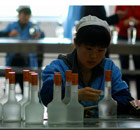Economy
Guangdong's growth target 'signals shift in industry'
By Qiu Quanlin (China Daily)
Updated: 2010-01-30 08:58
 |
Large Medium Small |
GUANGZHOU: Guangdong province, the country's economic powerhouse, has forecast a 9 percent GDP growth this year, a government work report said on Friday.
"After a tough year of tackling the global financial crisis, we will attach more importance to upgrading industrial structure to realize the goal this year," Huang Huahua, governor of Guangdong, said in a government report.
Specifically, the added values of the service industry will likely account for 46 percent and the investment in research and development (R&D) will increase to 1.8 percent of the province's GDP this year, Huang said.
This year's GDP growth goal, although set lower than last year's realized figure, reflects the provincial government's strategy to transfer its structure from manufacturing to service industry, deputies to the provincial people's congress said.
"The figure is bound to be lower if you cut more manufacturing industries, which used to account for a large percentage of GDP growth in the province," said Cai Zongze, mayor of Shantou.
The eastern city of Shantou, dotted with thousands of traditional toy and textile manufacturing units, plans to build "three economic belts" in future.
"Lots of companies focusing on modern service industries will move to belts. And we'll help traditional manufacturing industries upgrade facilities and expand production varieties," Cai said.











